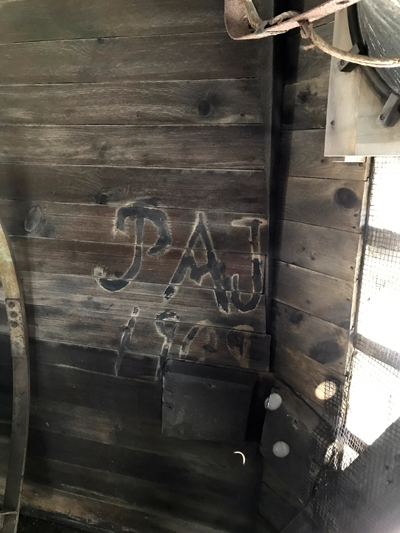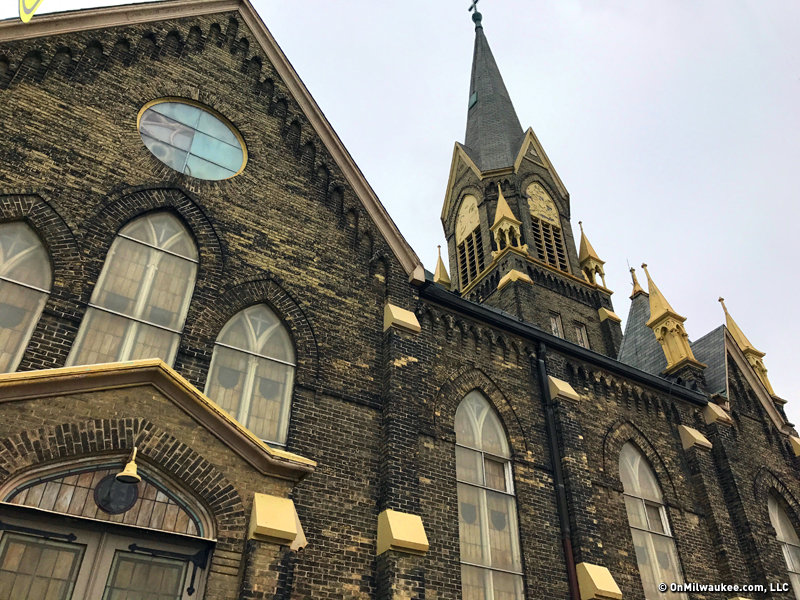There’s something special about visiting a place where history happened, where great men and women did great things. We all feel it when we visit a powerful historic site.
But for many of us – this guy included – history isn’t just famous people doing much-remembered things. For me, as for others who study their genealogy, standing in a place where our own ancestors did everyday things can feel equally powerful.
I don’t worship my ancestors, but I do appreciate the fact that the decisions they made are why I am here. This, despite the fact that surely I was but an abstract concept, was likely never even considered by my great-great-grandparents. It reminds me that my decisions will resonate across generations in small, and maybe big ways, even if the rest of the world doesn’t notice.


This is how I felt when I stood in the belfry at St. Martini Evangelical Lutheran Church, 1520 S. Cesar E. Chavez Dr., last month gazing down – through the mesh screen of the louvered opening – at the house my great-grandfather bought at the dawn of the 1920s.

It’s a house that every generation of my family (except my kids’) has occupied since arriving in Milwaukee from Germany in 1877.
It’s how I felt when I stood in the sanctuary where my great-grandparents stood as children for their confirmations. And it’s how I felt when I peered into the classrooms of the old school building next door, where my mom studied through the 4th grade.
Personally, I have no history with the church – my family started a long association with another South Side church at roughly the same time – but despite having never been inside before, St. Martini felt a little familiar; a little bit like home.
The fact that the church, built in 1887 to designs by Herman Schnetzky doesn’t hurt. Schnetzky (alone and, later, with partner Eugene Liebert) designed a number of gorgeous area churches, including Trinity/King Solomon on 4th and Meinecke, St. Michael’s on 24th and Cherry, St. Lucas on K.K. in Bay View and St. John’s on 9th and Vliet, among others.
His imprimatur is written on the city’s skyline in cream city brick Victorian Gothic spires. And even if only subtly or subconsciously, they’re familiar to us all.

(PHOTO: Karl Herschede)

St. Martini got its start in 1883, when 146 members and their families at St. Stephen’s on 5th and Scott in Walker’s Point headed southwest to start a new congregation to minister to the many Germans settling around the intersection of 16th, Muskego and Greenfield Avenues. My own family arrived and set up housekeeping on Pearl Street in this neighborhood.
According to the historic designation report for the church (which was landmarked in 1987), "The number of Lutheran congregations in Wisconsin between 1870 and 1890 increased 422 percent. St. Martini was one of the congregations that resulted from this expansion."
The same report avers, "Since the history of St. Martini is typical of many German Lutheran congregations in the city and was not the site of important innovations in any of these areas," it does not meet criteria for "historical significance" according to the Wisconsin Cultural Resource Management Plan.

(PHOTOS: Karl Herschede)
Fair play. However, as I noted above, it’s typicality and the fact that my typical ancestors led their normal lives here, at least in part, makes it significant to me. I’d suspect there are many others with roots in the neighborhood who would agree.
The report does go on to say, though, "St. Martini Church is architecturally significant to the South Side survey area and to the city of Milwaukee for its fine design and as a reflection of the late nineteenth century heyday of the near South Side as a maturing immigrant community."
In a neighborhood of steeples, St. Martini’s most definitely cast its silhouette on the horizon of this bustling area. Just like my mom – and perhaps her dad and grandparents – I can recall the peaked tower rising above the homes across the street. It was most definitely "significant."
As was common, the first structure built was a two-story schoolhouse on 15th Place and Orchard Street. The cornerstone was laid in 1883 with a plan that the first floor was to be used as a school and the open top floor would serve as a temporary church sanctuary.

The school and the church opened in 1844 and three years and $14,327 later, the imposing Schnetzky-designed church was ready. In 1892, an addition was put onto the south side of the school, adding two classrooms.
A parsonage was also erected in 1884, but was replaced with the 1929 version we see today. Another school building and hall was built to the south of the parsonage in the 1960s.

The church itself is a High Victorian Gothic structure with pinnacles and the decorative basket-weave brickwork we expect from Schnetzky, who also added his trademark chimney at the peak of the gabled roof where the nave meets the apse behind the altar.

There’s a clock on the tower and three bells up in there, too. Though Pastor Alfonso Prada told me the bells don’t work anymore, he didn’t object when I reached for one of the ropes and pulled it, to find to our delight that they do, indeed still work. Up in the tower, there’s a graffito from 1909 and a painted note saying that painters did their job up there in 1950.
Though the route to the bells isn’t an especially rough one – requiring a couple staircases and a long ladder – we decided again the final leg of a potential journey to the peak: a hand-knotted rope ladder of indeterminate age.
Back down in the sanctuary, the church is quite fetching with an altar screen and pulpit from 1931, but in a traditional style. The pews were replaced a few years earlier, but, again, fit quite nicely.
There are some beautiful colored glass windows throughout, in lovely muted tones, and a pair of murals depicting Jesus flank the altar. Keen eyes will note in the one on the left that Jesus has six toes on his right foot. Turns out representations of a six-toed Jesus are not uncommon and there's a whole belief system that accounts for this. Google it and you'll find plenty on the subject.

 Upon entering from the apse side of the church, one’s eyes are immediately drawn upward to a vaulted plaster ceiling that makes the sanctuary feel even larger than it is (early newspaper reports say it could seat 600).
Upon entering from the apse side of the church, one’s eyes are immediately drawn upward to a vaulted plaster ceiling that makes the sanctuary feel even larger than it is (early newspaper reports say it could seat 600).
Next, you see the curvaceous balcony – home to an elaborate organ pipe arrangement – which will remind you of similar examples at Trinity/King Solomon and St. John’s.
Though these days, the choir loft more closely resembles the shorter one at Trinity/King Solomon, it was originally built to extend further toward the altar, as the one at St. John’s does today.
In 1931, the balcony at St. Martini was brought back to its current position. At the same time a narthex – or entry area – was created with the construction of a wall at the back of the sanctuary, beneath the balcony.
I didn’t get to see the parsonage and I wasn’t especially interested in the much later school building – though I did get a peek inside to see if the eight bowling lanes and a bar were still in the basement (no, they’re replaced by classrooms and a cafeteria).

The pins and pin setters were at this end. All gone now.
But, I was eager to see inside the old school building.

Much altered on the outside, with many windows bricked up and any architectural ornament removed, the school looks exactly as my mom remembered it from her time there in the late 1940s and early 1950s.
In fact, in many ways, it appears unchanged since its construction. There are built-in wooden benches flanking the Orchard Street entrance.
The hardwood floors are original and you can even see the discoloration where the old-style iron and wood desks were bolted to the floor.
The wainscoting survives on the walls, the classroom doors are imposing and heavy, and the wooden stairs to the second floor have that comforting wear and creak that comes with use and age.
Upstairs, the space used initially as a church, and later as a school assembly hall, has been carved up into two classrooms to help accommodate the roughly 280 students that currently attend St. Martini School, which is now part of the Lumin group.
Interestingly, peak enrollment here was 429 in 1897 and some 1903 class registers (the photo below is from that year) suggest that these rooms once held up to 70 or 80 kids at a time, which seems astonishing to modern sensibilities.


What struck me most about my visit to St. Martini is that all these years later – long after my German immigrant ancestors have shrugged off this mortal coil – is that St. Martini is still an immigrant church and school – now predominantly Latino – and still a vibrant and important presence in the neighborhood.
In that way, it continues to write these little histories every single day.
Returning to Our Roots
On Saturday, May 13, St. Martini will host a special worship service and fellowship lunch at 11 a.m. The event, called Returning to our Roots, aims to unite old and new members of the church, as well as sister congregations, friends and community members to honor the history of the church and help it move forward by supporting the church's missions and ministries.
To RSVP, call (414) 645-4094 or email stmartini1@yahoo.com.
Born in Brooklyn, N.Y., where he lived until he was 17, Bobby received his BA-Mass Communications from UWM in 1989 and has lived in Walker's Point, Bay View, Enderis Park, South Milwaukee and on the East Side.
He has published three non-fiction books in Italy – including one about an event in Milwaukee history, which was published in the U.S. in autumn 2010. Four more books, all about Milwaukee, have been published by The History Press.
With his most recent band, The Yell Leaders, Bobby released four LPs and had a songs featured in episodes of TV's "Party of Five" and "Dawson's Creek," and films in Japan, South America and the U.S. The Yell Leaders were named the best unsigned band in their region by VH-1 as part of its Rock Across America 1998 Tour. Most recently, the band contributed tracks to a UK vinyl/CD tribute to the Redskins and collaborated on a track with Italian novelist Enrico Remmert.
He's produced three installments of the "OMCD" series of local music compilations for OnMilwaukee.com and in 2007 produced a CD of Italian music and poetry.
In 2005, he was awarded the City of Asti's (Italy) Journalism Prize for his work focusing on that area. He has also won awards from the Milwaukee Press Club.
He has be heard on 88Nine Radio Milwaukee talking about his "Urban Spelunking" series of stories, in that station's most popular podcast.







